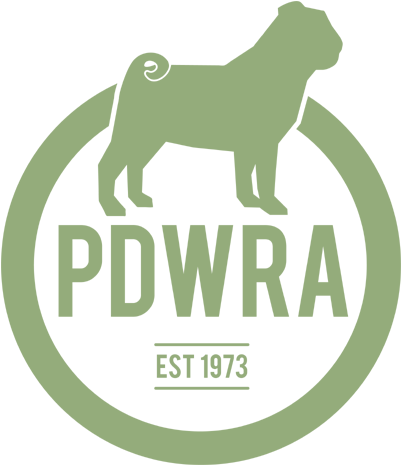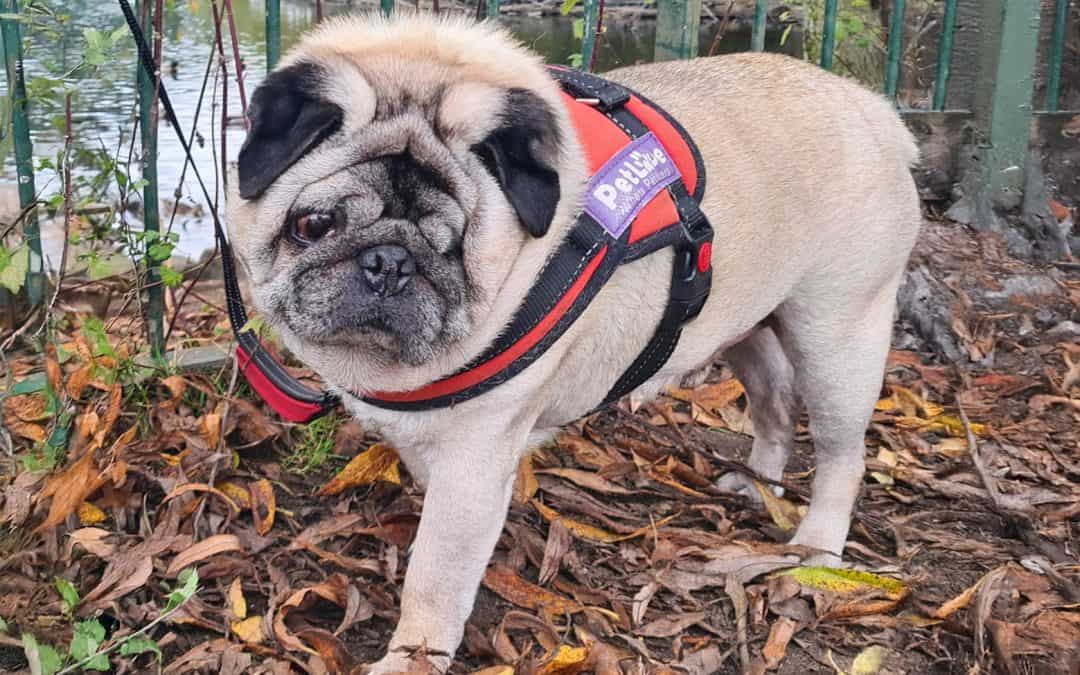
by Yasmin | 7 Aug, 2025 | Blog, In Memoriam
We lost one of our stalwarts of the pug world on 19 July 2025. Dear old Ralph who coped with a multitude of problems throughout his life but despite all, took and gave pleasure to those who came across him
Ralph was surrendered in 2019 by a lady who saw him advertised on Facebook. She took him on with the best of intentions but a combination of family circumstances and Ralphs physical and mental needs dictated that she could not care for him long term. He was blind, one eye removed after a dog attacked him, the other became infected so much that it left him with no vision at all. He had been confined, and due to the disorientation suffered from loosing his sight, barked and span round in circles in frustration and despair. Knowing all this, Caroline took him on to foster and gave him all the love and understanding he needed. He gradually improved as his confidence grew, and led a contented and stimulating life.
I met Ralph in June 2021 when I collected Poppy, also being fostered by Caroline. He was a cheerful little chap then, despite his disabilities. Poppy was quite a dominant pug and it was thought best for both if they were parted.
The next I heard of Ralph was in August 2024 when I received a call from Caroline’s daughter to say that her Mother had passed away. She, nor any member of the family were able to care for Ralph, especially with his multiple needs.
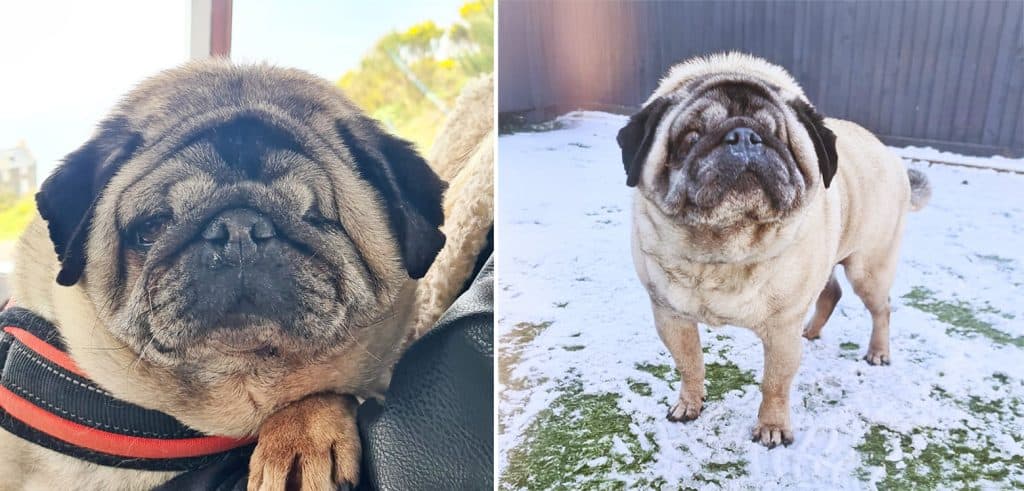
Even with our dedicated band of Foster Carer’s it was a challenging remit to find a new placement for Ralph. Louise stepped forward however, and said she would see how it worked out. She is caring for Albie, another veteran, so thought that one more should be no trouble. After a challenging first few weeks, Louise and her family gradually got to know his ways and he soon became a much loved member of the family.
Ralph’s condition by this time had stabilised, and although still needing extra care, Louise was able to fill his life with stimulating and rewarding experiences. At first believing he was totally deaf, she later discovered that he could hear – the ping of household applicances, the applause at sporting events on the TV (Louise was sure he thought they were applauding him ! (He became a big fan of tennis ).
Louise only had the pleasure of his company for eight months but all four seasons were packed into that time with him. He loved to visit Stately homes and Markets, visited the seaside and had a ride on a steam train. But his favourite time was the evening when cuddles on the sofa in front of the TV were the order of the day. So many memories packed into such a short time, how he will be missed. Rest in peace you dear, brave little man.
Jackie Maynard
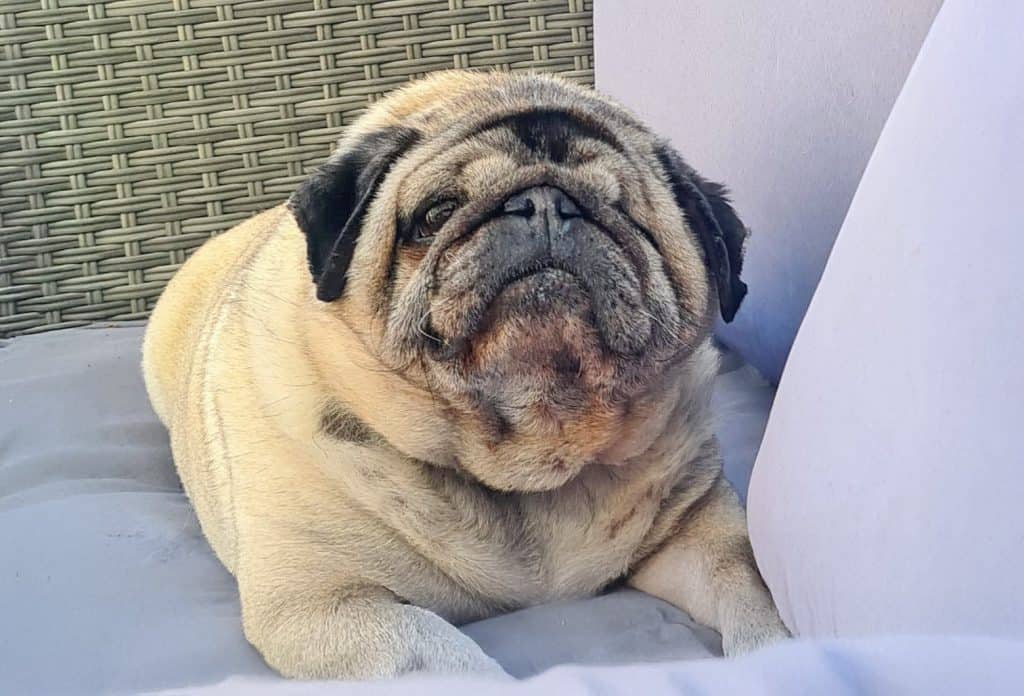
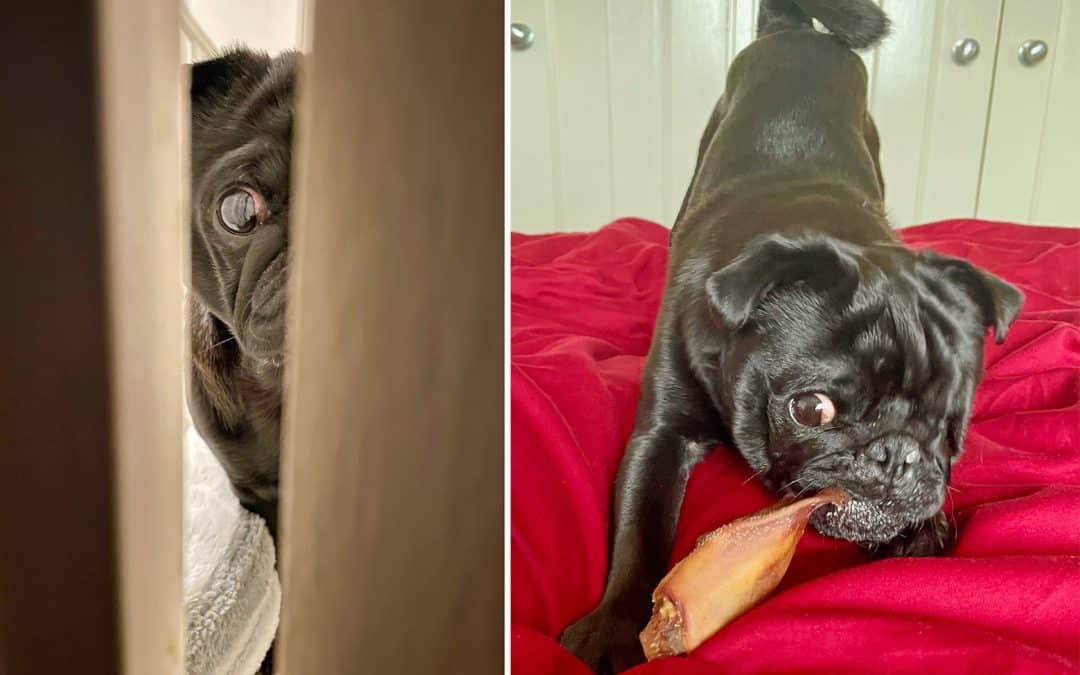
by Yasmin | 7 Aug, 2025 | Blog, Rescue Stories
We are a family of dog lovers who had dogs in the past, but when I had some health problems and we weren’t sure whether we had the capacity to offer a dog a long term home.
We’d been a dogless family for several years and we were all yearning for the pitter patter of little paws around the house. I’d never considered fostering before but when I started researching rescues online it became very clear that rescue charities were desperate for fosterers, and this seemed like a good option for us – a way to help a dog in need without the permanent commitment, just in case it didn’t work out. At first, my husband was worried that fostering was cheating somehow, or that we’d be jumping the queue if we did want to adopt, but when I showed him how much charities needed fosterers, he was soon onboard. Out of nowhere, our son suddenly developed an obsession with pugs, and after a quick internet search we found the PDWRA and our lives were changed forever!
We submitted the application form to become fosterers and had a home visit with a lovely PDWRA volunteer to check our home was suitable. We didn’t tell our son it was a pug charity, just that we were interested in fostering a dog. A couple of weeks later I had a call from the Volunteer Area Coordinator (VAC) for our area asking if we could take a foster in, and so our foster journey began.
We quickly fell in love with fostering and all adored having a dog around. Our son was over the moon to have a pug in the house, and we soon adapted to life with a dog again. The first foster was difficult to say goodbye to, but we all agreed that we weren’t quite a perfect fit, plus, the PDWRA had found a perfect home. It was strange to have a quiet home again, but we were so excited when we got ‘the call’ from the VAC about taking another foster pug.
We’ve fostered 7 pugs through the PDWRA in total, and very much hope we can foster again in the future. Each pug that came to us had their own unique personality and challenges. The PDWRA were always on hand if we needed support or guidance. With each new pug it was getting increasingly difficult to say goodbye. We felt we could offer a great temporary foster home, and that was often helping a dog coming from difficult circumstances, but I still worried that it wouldn’t be fair on a dog to adopt due to the complications of my health issues.
Then came Ozzy.
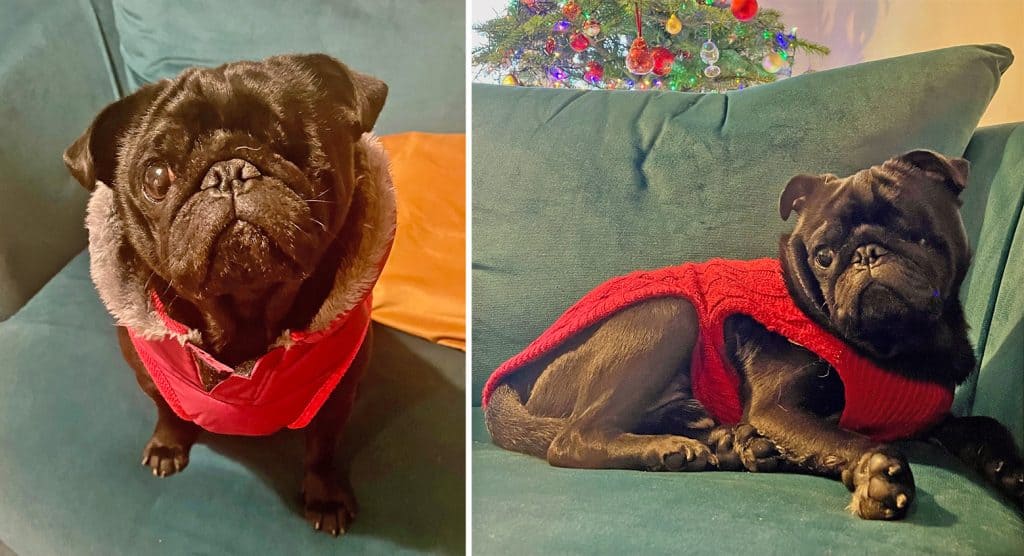
Ozzy came to us as a foster in April 2024. He’d had a difficult start in life. While we had no intention of adopting, as we’d really enjoyed fostering, there was just something about Ozzy’s energy, he just seemed so happy to be with us. He was lapping up all the attention and as each day went by, I saw him become more grounded, as if he were saying ‘ahhh, I’m safe now’. We felt this overwhelming feeling that he was home. We also felt that it would have been just too hard to say goodbye, and that despite the challenges of my health, he didn’t care about that one jot, what we had to offer was enough for him.
So, we quickly let our VAC know and once we’d had all the fostering medical assessments sorted, we signed the paperwork and transferred the adoption fee (we’d already had a home check to become fosterers). All very straightforward.
Ozzy came to us with a few health issues – allergies and eye issues, but the PDWRA have been so helpful in guiding us through managing these. He did need some support with his behaviour too, as after a difficult start in life, he struggled to feel safe – especially around new people. He had sadly lost one of his eyes due to neglect before coming to us and was understandably not a fan of the vets, or people touching his face and head.
With a lot of love and patience, Ozzy has come on leaps and bounds! I always loved to see the progress our foster pugs made with us, even though they were only with us for a few weeks. Watching Ozzy blossom over the last year has been wonderful and leaves me with an enormous sense of awe! He’s doing so much better with people and is so much calmer. He’s been socialising with dogs and people, and we very much hope that if he continues to improve we can foster again, so that he has a friend every now and then, as he does love to play.
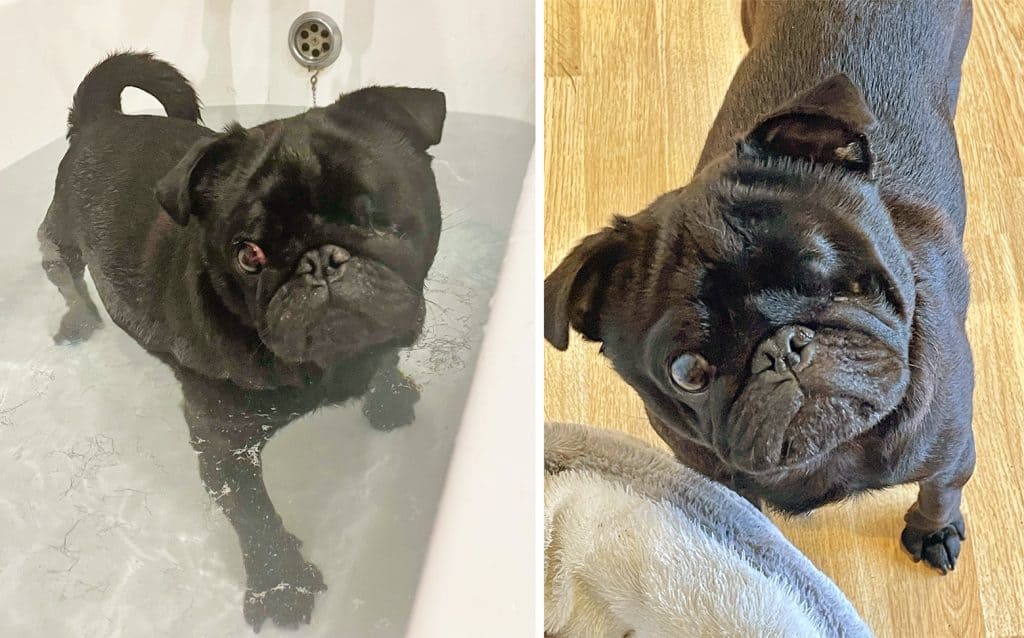
Ozzy can be so funny and mischievous, but he’s also so bright and quick to learn.
His zoomies around the garden are always a joy to behold and the way he scratches the kitchen bin to demand his dinner makes us laugh.
Like a typical pug, Ozzy is very food oriented – which has come in handy for training, but also gets him into mischief – he quickly learned that there were delicious delights to be found in the strawberry patch! At first, we couldn’t quite understand why we weren’t getting any strawberries, then we figured out it was just our cheeky boy getting to them before us!
We initially had some challenges with Ozzy and my 10-year-old. At first, Ozzy could be triggered by people moving suddenly, and children are not known for their ability to keep still. However, with time and patience and lots of love, they are doing so well together. We got my son to feed Ozzy every day, go on walks together and get involved in training. Now Ozzy sleeps on the end of my son’s bed each night – we actually ended up getting our son a bigger bed so they both had more room! They love to snuggle and run around the garden together.
My husband says: “It was great fostering, but life feels complete with little Ozzy. I love taking him to the local cricket ground and watching him run with his friends, 2 big Labradors. They’re so much faster than he is, but he perseveres. Due to having only one eye, he can sometimes veer off to one side and gets lost but soon finds his ways back to us. We live out in the countryside, but without a dog I forget to get out and enjoy it. My morning walks in the fields with Ozzy are so peaceful and calming.”
I’ve always been highly impressed with working with the PDWRA. The positive community ethos they have fostered is wonderfully supportive. Our Volunteer Area Co-ordinator, Dee, has always been amazingly understanding and helpful! Thank you!
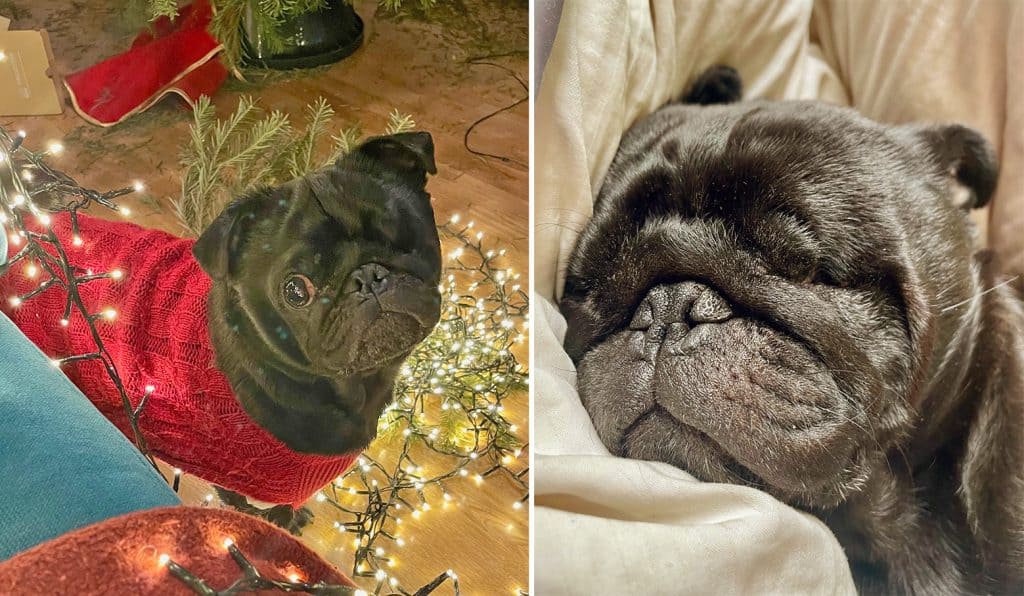
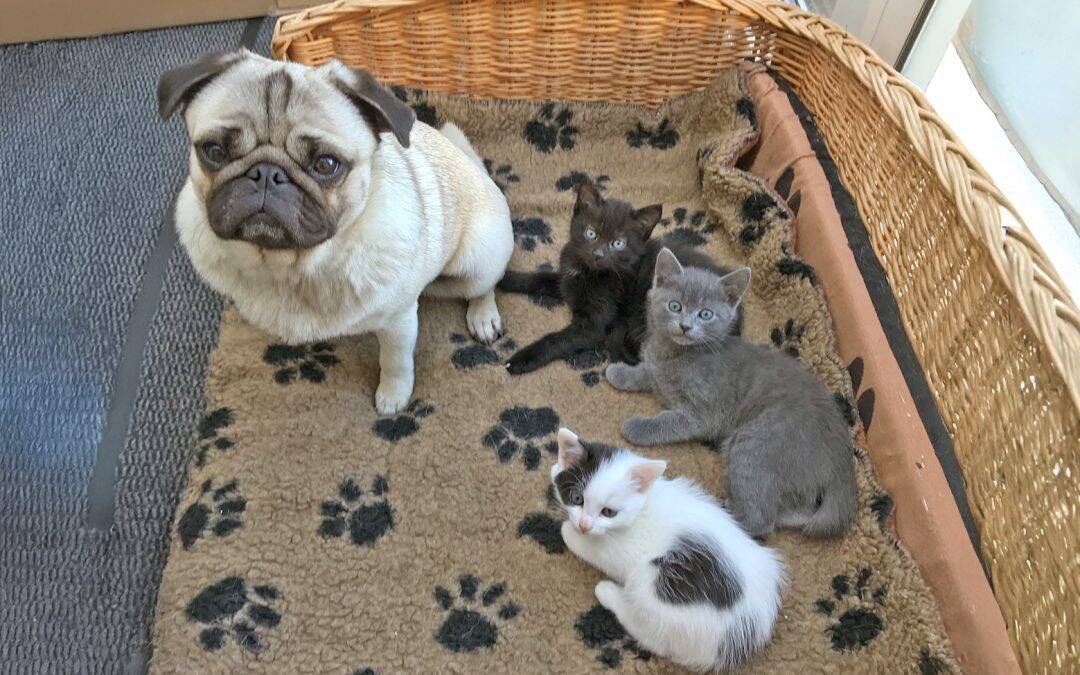
by Yasmin | 7 Aug, 2025 | Blog, News
Iris hanging out with the kittens
Meet our new Trustee – Anne McDonald
My name is Anne and I’ve recently become a Trustee for PDWRA. This is a bit about me…
I’ve been a dog owner from the age of four, my grandad’s dog had puppies and he gave me one for my birthday. She was a mixed breed called Trixie, since then I’ve never been without a dog. My first dog after getting married to Dave was my beautiful Rottweiler Roxy. She was joined by another Rottweiler and a Labrador; I’ve also owned a Bullmastiff and a Border Terrier. I now have pugs!!
I’ve worked as a Local Authority Dog Warden since 1989; I was the first full time warden to be employed at the authority and during my first year over 600 stray dogs were picked up and taken to our kennel. Needless to say, I wasn’t the most popular person at the authority! I absolutely love my job, it can be very challenging, heartbreaking at times but also so rewarding.
During the working day I can be involved with stray dogs, dangerous dogs, noisy dogs, cruelty, dogs causing a nuisance, dealing with animal licences including Riding Establishments and the keeping of performing/ dangerous animals, and anything else that the office thinks I can do. I’m also a fully qualified pest control technician and a licensing officer.
I have two grown up boys, one’s a history teacher and the other works in theatre. I like fast cars and fast horses, I’ve ridden since I was 9 years old and did work with horses in my younger days, I was a qualified teacher and did enjoy teaching. I’ve owned my own horses, usually thoroughbreds, but sold up after breaking my back in 2010. Anyone who has horses knows it’s in the blood, so I do ride as often as I can. My other great love is the theatre, and I go as often as I can, either local or to the West End.
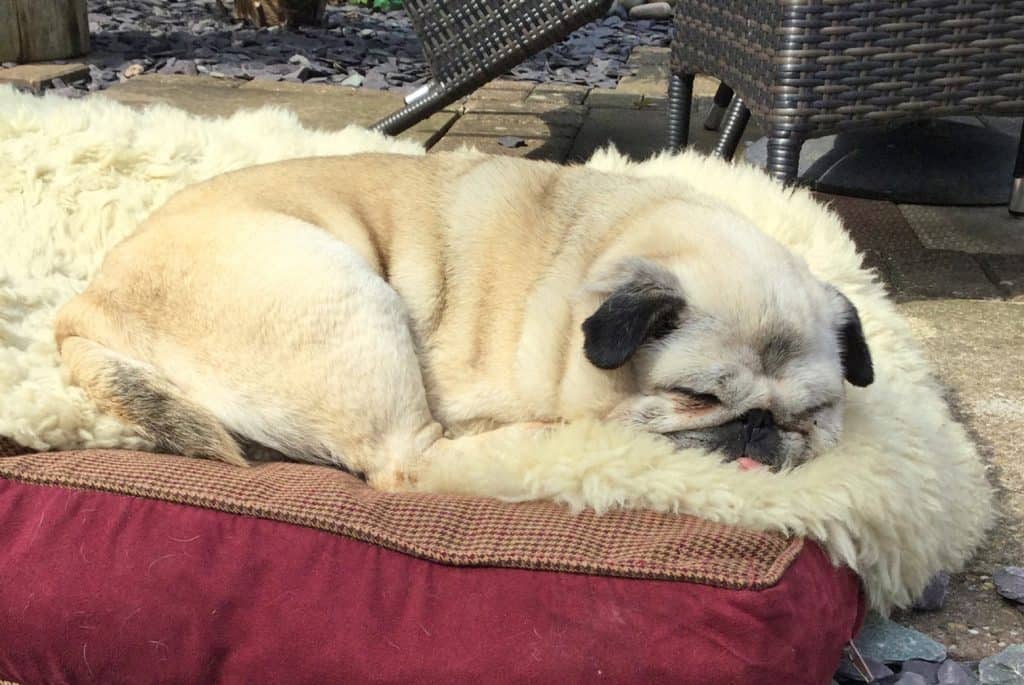
Anne’s first Pug – Lucy
My first introduction to pugs was when I got called to a property where the occupant had died and a pug was left inside. His name was Charlie Chan and what a character he was. I remember contacting PDWRA and the lovely lady I spoke to, who was very well spoken, said “my dear, are you absolutely sure that it’s a pug?!“ They subsequently came to collect him, as we have always tried to work with breed rescues.
How did I end up living with pugs? Well, I had been dealing with a backstreet breeder for a while, removing dogs she no longer wanted. On one of the visits, a little fawn pug was in a tiny green cat house completely wired up with hardly enough room to turn around. I said to the owner that if she no longer wanted her I’d take her to rescue. 18 months later there were two pugs, this time she’d put them in a shed. Again, I suggested letting me have them but she said no, however, I was on my way to the kennels with a Labrador when she phoned to say she no longer wanted the pugs as they kept jumping up on her! Honestly, I think the poor Labrador got whiplash as I turned around so fast, and this is how I ended up with Lucy and her daughter Minnie.
Neither had ever been walked, or seen the great outdoors, and a short while later Mikey was born to Minnie, as she had been mated before I had her. I ended up paying for a caesarean and of course I kept the one puppy! I’d never really thought about having a pug or two, as I didn’t really know much about the breed. I’ve always loved big breeds and terriers, which was where my knowledge was, but was thinking ‘they are just dogs aren’t they? How difficult can they be?!’ Haha, as any pug owner knows, they are totally unique. How silly was I?!
Dave was at work when I brought them home and had no idea they would be joining us! He didn’t think he liked pugs, that was 24 years ago! We then adopted Alfie, who was from Leicester Animal Aid, the charity we use for our stray dogs. Alfie had two unsuccessful homes after being gifted to the centre, then I was greeted with ‘Anne you’ve got pugs, haven’t you?!’ So, Alfie came to live with us, a super little pug who was never a problem in any way. He lived to the grand old age of 15.
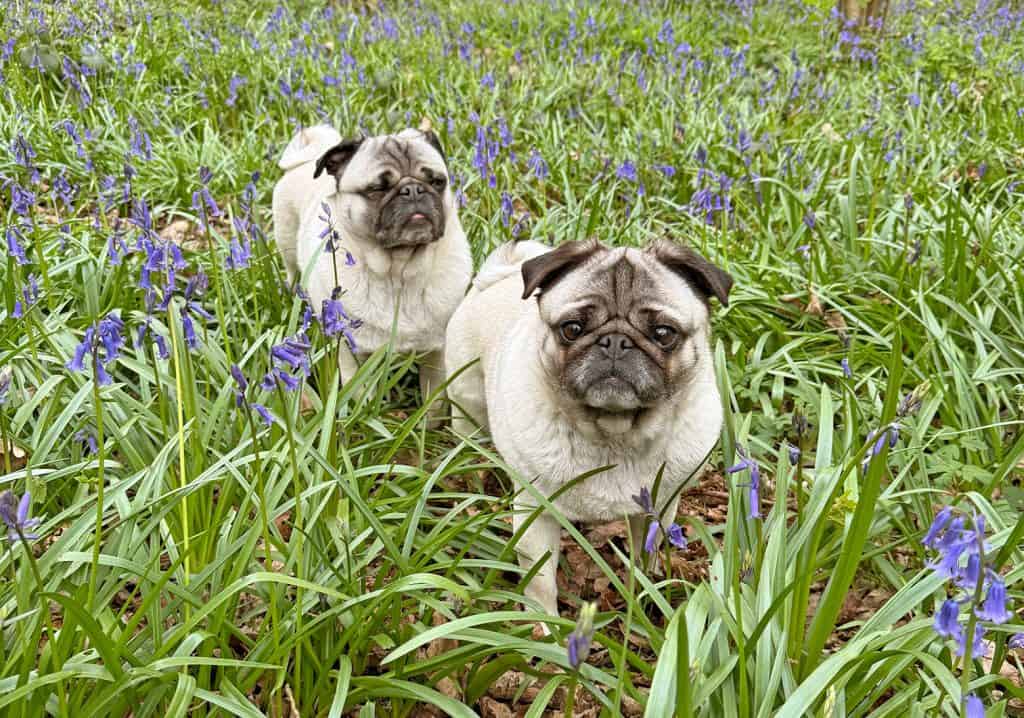
Bertie & Iris out for a walk
After losing Lucy, Minnie and Mikey, I bought pugs for the very first time, which are the two I’ve got now, Bertie and Iris. I have adopted a pug from PDWRA, but sadly lost him aged 8. Percy came to me as a pug that would bite, and he did, quite a few times! Although I’ve had many foster pugs I wasn’t happy about Percy moving on, so I adopted him. He was quirky, but lovely! He absolutely adored Dave and never made any attempt to bite him!
Bertie and Iris are now 8 years old, they have been to Crufts, to discover dogs and on the PDWRA stand. They are typical pugs and are happy to go anywhere, as long as they are with you, they will travel around London on the tube or bus, they love Richmond Park and always enjoy a beach walk with an ice cream at the end. They live with 4 cats and 2 tortoises, their very best friend is Thor, a German Shepherd I rescued as a very underweight puppy who now lives with my friend. This is one of my happy endings!
I have been involved with PDWRA since 2014, first as a volunteer, then as a VAC. When I knew they were looking for Trustees I applied, as I felt my knowledge of dogs, dog behaviour and dog law could be helpful. Aside from that, doing the other roles gives me an insight into what goes on and how much work the volunteers do.
Going forward I would like to see a joined-up charity, with everyone working together and helping each other. It’s so important to have a charity dedicated to the breed, with volunteers who are very knowledgeable and able to give helpful advice.
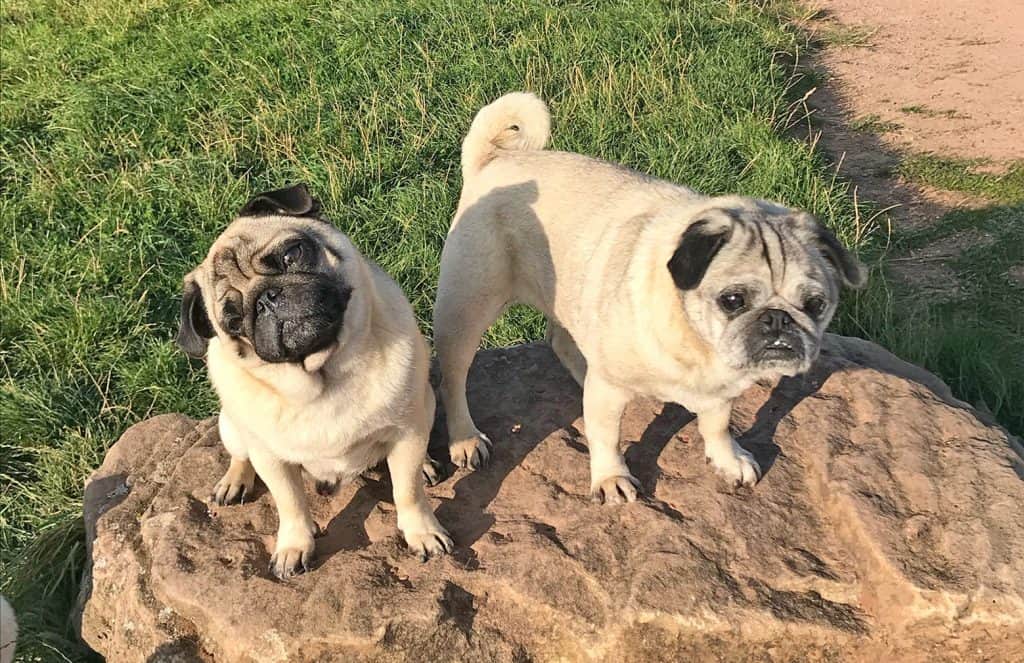
Percy & Alfie in the great outdoors
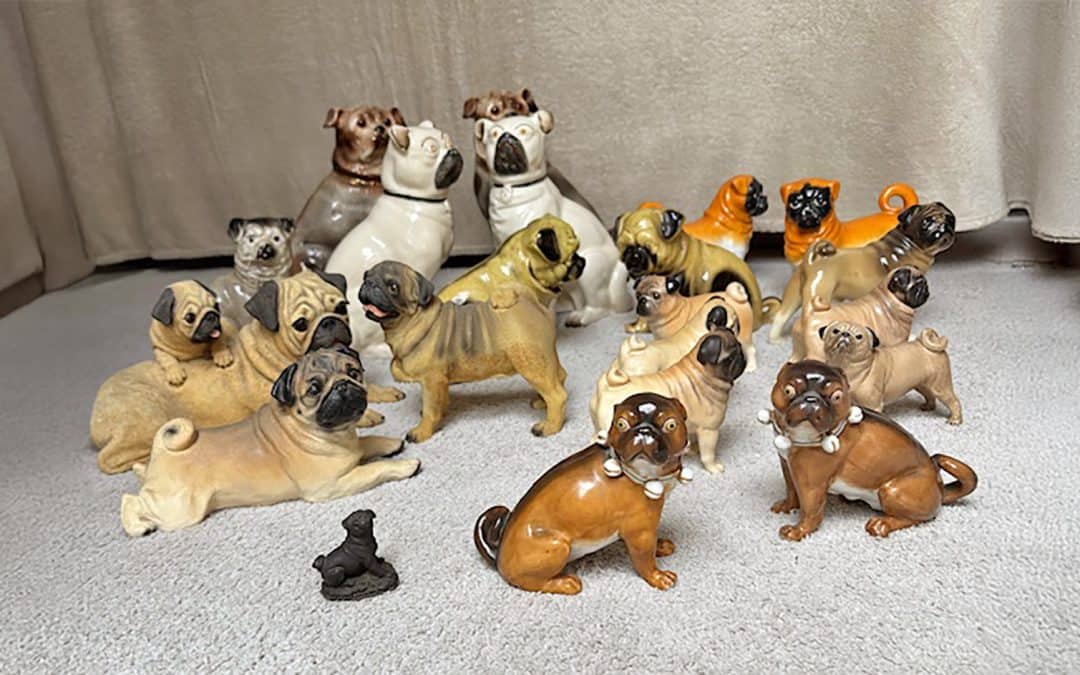
by Yasmin | 7 Aug, 2025 | Blog, In Memoriam
Loveday’s father leaves his beautiful collection of ceramic pugs to the PDWRA.
My father was a pug enthusiast for most of his life. Shortly after my parents married, 70 years ago, they welcomed a pug called Bunky into their lives and things were never the same again. Growing up, I can’t remember a time when there wasn’t at least one pug, often more, in our family, and this continued for the rest of my Dad’s life. The pugs’ larger than life personalities and snuffly enthusiasm for food, walks and comfort took priority in all aspects of domestic life including holidays (of course the pugs never went into kennels!).
Over the years, Dad registered with the PDWRA as an adopter and took on a succession of pugs in need of a safe, loving home. He helped them through their trauma and health issues so that they could live their lives happy, warm and without fear. His commitment meant that he sometimes drove hundreds of miles from his home in Cornwall to collect a pug that needed rehoming. His last pug, Ruby, was left partly disabled after being badly abused as a youngster, but Dad answered the PDWRA’s call for help and looked after her for many years. After Dad died in 2024, we reached out to the PDWRA to re-home a now elderly Ruby, who was missing her favourite human terribly. The volunteers were fantastic, quickly identifying a wonderful new home where Ruby spent her final months in the lap of luxury alongside some very friendly pug companions.
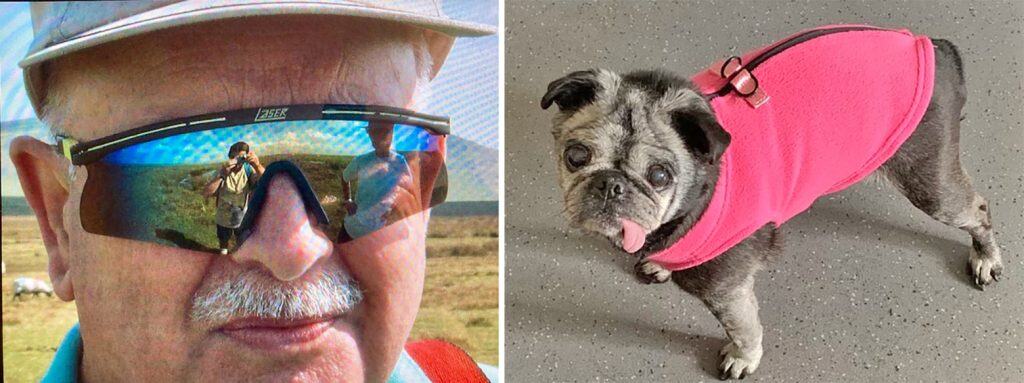
Pictured above is Loveday’s father, alongside his last pug Ruby
Dad’s pug obsession extended beyond the furry ones, and he built up a collection of ceramic pugs, always on the lookout for new additions. There is a mix of old and new items and Dad enjoyed them all, but he also wanted to use them to help the pug rescue community. So, in his will he gifted them to the PDWRA with the intention of them being sold to raise funds for the organisation he was proud to support. I’m so pleased that the PDWRA has accepted this legacy and will be doing just that. Dad would be so pleased that his collection will help pugs in need and have a new life with fellow enthusiasts.
Loveday Lamb
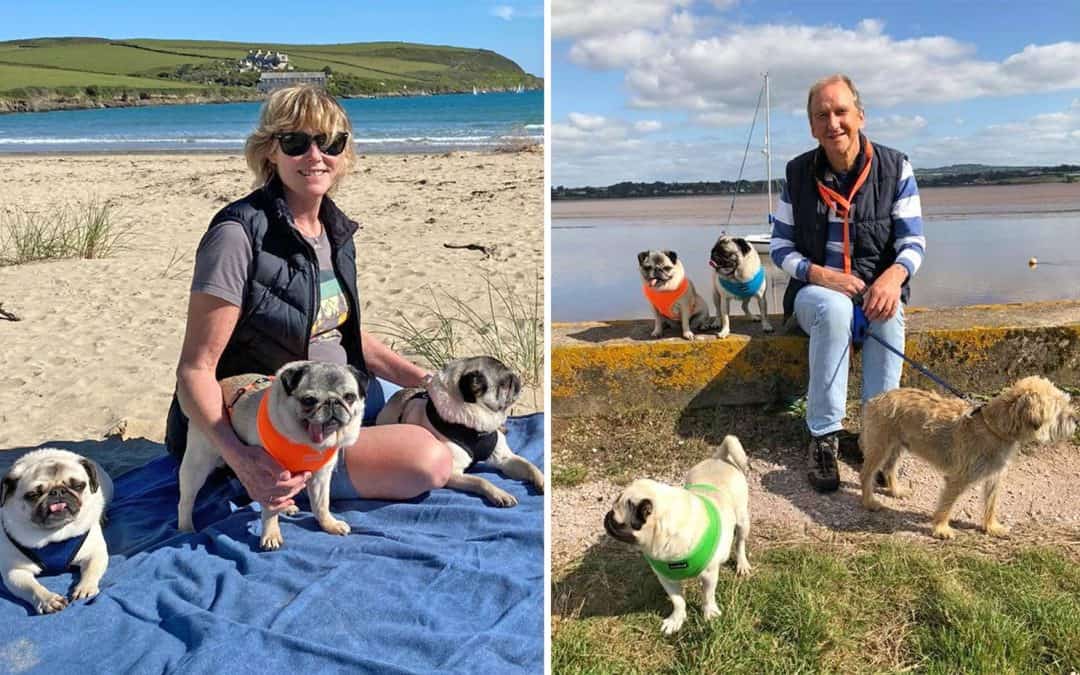
by Yasmin | 7 Aug, 2025 | Blog, News
We are saying a sad farewell and a huge thanks to Helen & Malcolm McKee – Voluntary Vet Advisors to the PDWRA from 2018 – 2025
Helen first became involved with the Charity in early 2018, when she made an initial approach to enquire about fostering. At the time, she said ‘I volunteered my services at the local donkey sanctuary for a brief period, but I need a role that will keep the grey matter working’.
In June of 2018 Helen & Malcolm collected and fostered a fawn female pug called Suki, aged 8yrs. Suki required BOAS surgery, plus an extensive dental overhaul, and her adoption happened very quickly, as both Malcolm and Helen soon became besotted with her.
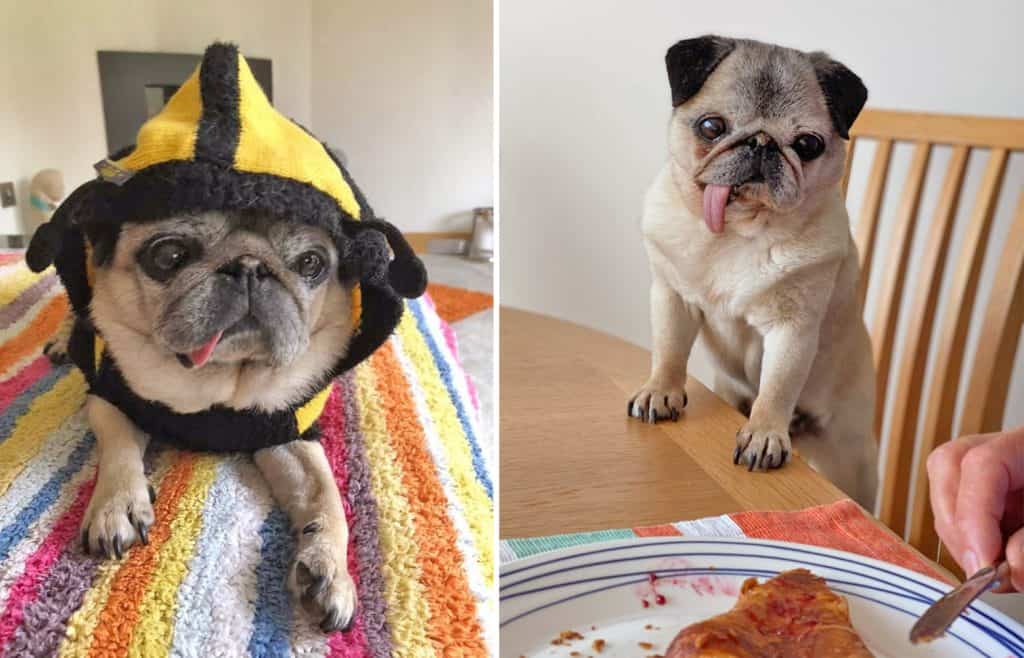
In the months that followed, Helen took on the role of Volunteer Area Coordinator for the Wales region. Through the experience of doing this job, Helen and Malcolm both became very aware of a need to support and advise all of the area coordinators around the UK with valuable veterinary advice. Over time, they both became voluntary veterinary advisers to the Charity, giving a huge amount of their time to supporting the hundreds of pugs coming into our care and overseeing their medical treatment.
Helen and Malcolm have both been absolute rocks for the Charity over the last 7 years and done so much to help pugs in need to live their best lives. It’s very hard for us to imagine the Charity without them, constantly on call to offer much needed help and advice, but they have now come to the very hard decision to take a step back in order to be able to spend valuable time with their growing grandchildren.
Over their time spent helping the Charity, Helen and Malcolm fostered a total of 10 pugs. All of us at the PDWRA will miss them both terribly and will be eternally grateful for the gracious and caring way that they shared their valuable knowledge for the huge benefit of everyone involved.
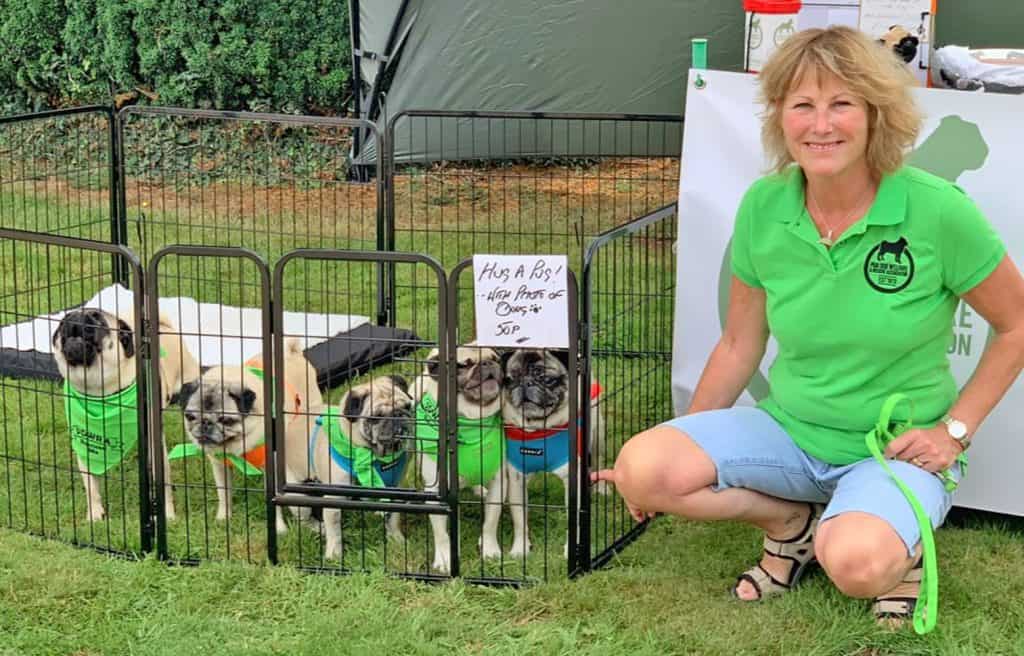
*******
Helen and Malcolm provided regular pug-health articles on many topics. These can be found in our pug health section:
Pug Health & Wellbeing



















